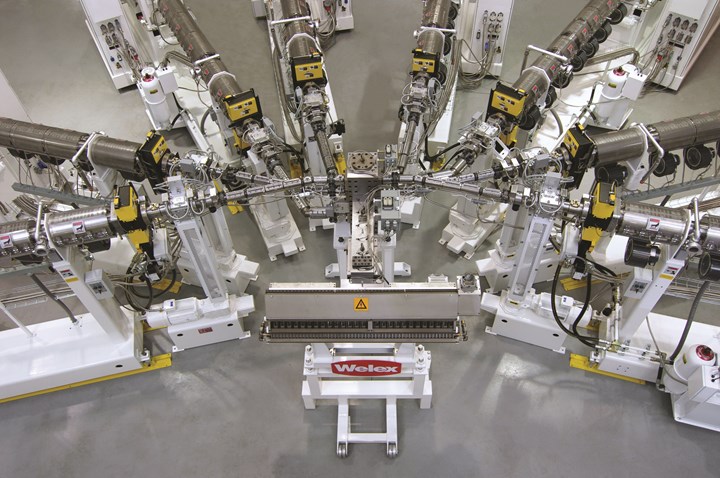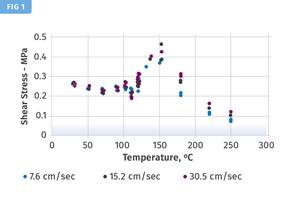What You Need to Know to Get into Coextrusion
Key considerations range from determining the right extruder sizes to tooling, matching material viscosities, and lots more. Take a look.
Coextrusion requires far more polymer and extrusion knowledge than monolayer extrusion, so operating personnel need to be properly prepared. And there’s lots to consider,
First, it’s necessary to select polymers that meet a host of performance requirements in the finished extrusion and will also bond to form a strong structure. Bonding is largely dependent on the respective surface energies of the polymers. If the polymers selected for the performance requirements of the finished coextrusion do not provide adequate bonding strength, then it will be necessary to use tie layers, which will require additional extruders.
Among the many performance factors to consider—determined by the final use of the finished product—are flexibility, chemical resistance, permeability and ideal layer placement, to name a few. For sheet and cast film applications in particular, processors must choose between a multi-manifold die or a coextrusion feedblock. Coex feedblocks generally provide more flexibility as well as lower initial cost and less maintenance. Both have valves of various designs to adjust the layer flow rates, but melt pumps are typically used to precisely control the output of each layer. I suggest you evaluate and select from experienced coextrusion machine builders so they can provide you all the technical information necessary for the polymer selection, structure, and equipment design for a proposed coextrusion line.
Select polymers that meet performance requirements in the finished extrusion and will also bond to form a strong structure.
However, the actual daily operation of the line depends heavily on the melt viscosity exiting the extruders, which depends on the melt temperature and shear rates in the downstream tooling as the various layers are combined. Mismatching viscosities can result in numerous quality issues with a new coextruded product—even if everything was designed properly based on a similar coextruded product. This part of the process depends on the on-site operating personnel and their understanding of polymer viscosity with varying temperatures and shear rates.

Coextrusion can get highly complex and requires careful consideration of extruders, tooling, and material selection, among others. (Photo: Welex)
Polymer shear-rate/viscosity curves of different resins in a coex structure can actually cross over each other, resulting in a very narrow operating window, so the slopes of the curves or their power-law indexes should be considered when selecting layers. The glass-transition temperatures of the various polymers also need to be considered, as trying to match viscosities to avoid interfacial instabilities and layer distortion with a polymer that melts at 500 F layered with one that melts at 265 F is very difficult.
Also important is sizing extruders relative to their requirement in the structure, so they can develop similar melt temperatures without the need for special screws for every structure. I recently ran thin HDPE cast film on a line having three coextruders The three extruders (sized 3.5-in., 4.5-in. and 6 in.)generated greatly varying outputs—sometimes double. Because of this it was impossible to match the viscosities of the layers from all three extruders. And just about every kind of interfacial instability was present except at very low outputs, where the melt temperatures were relatively similar.
Polymer viscosity mismatch leads primarily to distortion of the layers.
Extruder output stability is naturally essential, both with respect to melt temperature and output, although melt pumps can be used to eliminate output variation bypassing the tooling valves, which can have more effect on melt temperature. For a given screw design, melt temperature is controlled primarily by the screw speed and head pressure, and generally to a lesser extent by the barrel temperature. However, the practice of adiabatic extrusion almost always helps stabilize the whole process. Adiabatic extrusion is seeking temperature settings where there is minimal thermal cycling of the barrel temperatures—i.e. no heat, no cooling.
 The shear-thinning effect is different for every polymer and grade. The individual curves are also offset up or down as the temperature decreases or increases, respectively. How the shear rate and temperatures affect polymer viscosity in the tooling can result in considerable variations in pressure drop through the die.
The shear-thinning effect is different for every polymer and grade. The individual curves are also offset up or down as the temperature decreases or increases, respectively. How the shear rate and temperatures affect polymer viscosity in the tooling can result in considerable variations in pressure drop through the die.
Polymer viscosity mismatch leads primarily to distortion of the layers. However, excessive shear in any of the layers can lead to melt fracture, usually corrected by raising the melt temperature—but that results in having to raise the temperature of each layer. Non-uniformity of melt temperature causes zig-zag patterns or wave effects in the sheet, so the most stable system possible is needed. Die swell varies between polymers and is a function of temperature and shear rate for a particular polymer and may require changes in the layer thickness to meet profitable operating levels.
These are meant as words of caution to those not experienced in coextrusion processing and do not apply in monolayer extrusions unless supplemental adapters and dies are also part of the equipment. With additional adapters and dies you can shut off and disconnect any extruders not required, as well as change or eliminate the feedblock or multi-manifold die. Additionally, proper training of the operating personnel on how to deal with the issues noted—as well as some not noted—will save a lot of time and scrap.
Even if designed for the same polymer, the screws are engineered for a certain melt temperature at a specific speed, which is usually at or near their capacity. Therefore, if you run one screw at one-third speed, another at two-thirds speed and the third at full speed, they will produce substantially different melt temperatures. Since polymers are poor conductors of heat and a good coextrusion block is designed to prevent intermixing of the layers, the layers will maintain their temperature through the coextrusion block and will thermally homogenize only in the die itself. It can take considerable time for the layers to stabilize at a single temperature.
For example, in the case of the thin HDPE cast film coex line cited above, it was necessary to run all three extruders to prevent degradation in the coextrusion block of resin from any extruders not being operated.
About the Author; Jim Frankland is a mechanical engineer who has been involved in all types of extrusion processing for more than 40 years. He is now president of Frankland Plastics Consulting, LLC. Contact jim.frankland@comcast.net or (724) 651-9196.
Related Content
Optimizing Barrel Temperatures for Single-Screw Extruders
If barrel temperatures are set correctly and screw design is optimized, the extruder will be operating at peak performance, providing maximum profitability. If not, bad things can happen impacting quality and profitability.
Read MoreIs a Gear Pump Right for Your Single-Screw Operation
As with everything else, there are pros and cons, but more of the former. They provide processors higher rates while decreasing the temperature of the extrudate while enabling downgauging.
Read MoreWhy Are There No 'Universal' Screws for All Polymers?
There’s a simple answer: Because all plastics are not the same.
Read MoreTroubleshooting Screw and Barrel Wear in Extrusion
Extruder screws and barrels will wear over time. If you are seeing a reduction in specific rate and higher discharge temperatures, wear is the likely culprit.
Read MoreRead Next
Beyond Prototypes: 8 Ways the Plastics Industry Is Using 3D Printing
Plastics processors are finding applications for 3D printing around the plant and across the supply chain. Here are 8 examples to look for at NPE2024.
Read MorePeople 4.0 – How to Get Buy-In from Your Staff for Industry 4.0 Systems
Implementing a production monitoring system as the foundation of a ‘smart factory’ is about integrating people with new technology as much as it is about integrating machines and computers. Here are tips from a company that has gone through the process.
Read MoreMaking the Circular Economy a Reality
Driven by brand owner demands and new worldwide legislation, the entire supply chain is working toward the shift to circularity, with some evidence the circular economy has already begun.
Read More
.jpg;width=70;height=70;mode=crop)














